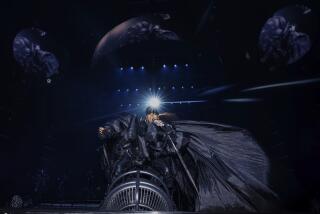Whitney Set Is Museum-Quality Ellington
- Share via
DUKE ELLINGTON
“Duke Ellington Live at the Whitney”
Impulse
* * * 1/2
The release of the new Beatles song “Free as a Bird” two weeks ago aroused a media frenzy. Premiered via video during the opening segment of a six-hour network Beatles tribute, and heard almost instantly thereafter on the radio, it was prominently featured in most major publications.
Did it matter that the song was an odd mix, the superimposition of new tracks by the three surviving Beatles over an existing John Lennon track? Or that its lightweight quality--certainly by Beatles’ and Lennon’s standards--made it little more than a mediocre Top 40 item?
Not much. By the time “Free as a Bird” made its debut, the long PR buildup had done its job well, playing into the enduring interest in the Fab Four, and in the process setting records for album sales.
So what does all this have to do with Duke Ellington?
Just this. At roughly the same time that the Beatles’ song was issued, this new, never-before-released recording also arrived. And, if the Beatles have had a broad musical and cultural effect upon a generation, Ellington has had no less significant an impact upon American culture for nearly three-quarters of a century.
Yet the album, unlike the Beatles’ song, appeared in the marketplace virtually unannounced and with negligible media attention. Why? Ask GRP Records. Once known as the home of contemporary jazz, GRP has recently become the steward of the classic Impulse catalogue of essential recordings--many by John Coltrane, some by Ellington--from the ‘60s. A few months ago, the Impulse label was resuscitated as a forum for new and reissued releases. Understandably, the initial Impulse distribution schedule concentrated on valuable reissue material.
But somehow, in the process, this valuable Ellington recording--as well as a similar, unreleased Coltrane collection, “Stellar Regions”--was essentially dumped on the jazz-buying public, packaged identically to the Impulse reissue material. Only a small sticker identified both recordings as “previously unreleased.” By way of explanation, Impulse’s marketing manager, Gabrielle Armand, says that the company believed it had “sufficient momentum” with the relaunch of the label to support the Ellington recording.
But that neither explains nor justifies why unheard recordings from two of jazz’s greatest figures should be released in such a manner, thereby failing to receive the visibility they deserve.
What we have here is a brilliant example of the essence of Ellington, and an argument-in-a-nutshell for his creative importance. Recorded during a concert at New York City’s Whitney Museum on April 10, 1972, it displays the master composer-pianist in the rare setting of an intimate trio--with bassist Joe Benjamin and drummer Rufus Jones--performing 17 individual selections and two medleys. It is one of very few recorded examples of Ellington working in such a spartan tonal environment.
The standard line has always been that Ellington’s orchestra was his instrument, and that his compositions were rendered for the individual members of the ensemble. But recent programs by Wynton Marsalis’ Lincoln Center Jazz Orchestra, as well as the playing of Ellington groups (in the early ‘50s, especially) with differing personnel, revealed that the essential excellence of the compositions reached well beyond the work of any single musician.
Ellington’s coolly elegant, almost offhandedly casual readings of such classics as “Sophisticated Lady,” “Mood Indigo” and “Prelude to a Kiss,” as well the far less familiar “Amour, Amour” and “Le Sucrier Velors,” further underscore the music’s richness.
No, the timbral lushness of the Ellington orchestra isn’t present, but the tonal colorations of his harmonies, the easy-surging rhythms and the ineffable melodies can be heard in their full glory. And there is the additional benefit of a relaxed, chatty Ellington, obviously in fine form, interacting humorously with his enraptured listeners.
Despite the importance of his music, however, Ellington has not yet made a full transition from the jazz world to the wider universe of American concert music in the two decades since his death. That progression, in which Ellington could be viewed in a context with Copland, Barber and Bernstein, is favored by many observers in both jazz and concert music.
And it may be coming soon. Marsalis’ dedicated exposition of the Ellington repertoire with the Lincoln Center Jazz Orchestra, the growing availability of a variety of books and videos, the persistence of the Ellington popular song catalogue all suggest that a revival may be in the making.
It will have to survive careless handling. No one expects an Ellington recording, previously released or not, to be accorded the same kind of mass-media attention received by the Beatles. But there is no reason why Ellington’s music, especially in the case of a performance this rare, should be denied a reasonable measure of advance publicity and promotion.
The Beatles will undoubtedly sell more product, but one suspects that if jazz fans in general and Ellington connoisseurs in particular are properly informed about the availability of a splendid, previously unreleased Ellington performance, they will make “Live at the Whitney” a valuable catalogue item with long-term sales potential.
Albums are rated from one star (poor) to four (excellent).
More to Read
The biggest entertainment stories
Get our big stories about Hollywood, film, television, music, arts, culture and more right in your inbox as soon as they publish.
You may occasionally receive promotional content from the Los Angeles Times.










